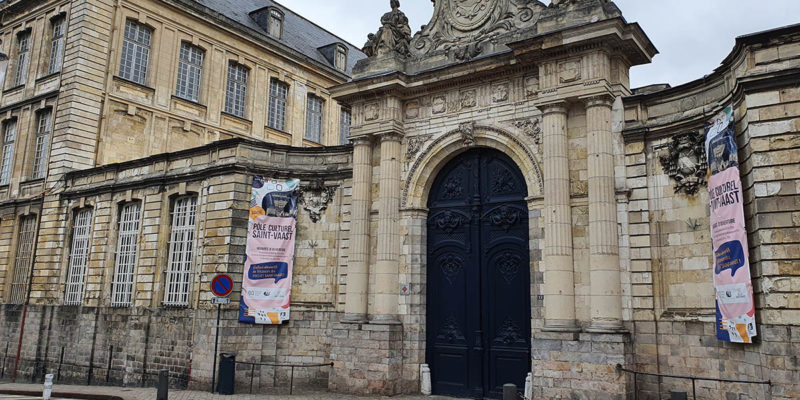As mentioned in our Nemetacum and the Germanic invasions that destroyed the town of Arras in the early 5th century, the Christian Franks, led by Clovis, took up a position in what was to become Arras. Particularly renowned as builders but also evangelizers, these Franks conquered the whole territory between the Somme and the Scheldt, according to the Benedictine monk Jonas of Bobbio in the 6th century. But what about the nascent bishopric of Arras ? Who was Saint Vaast?
The Frankish federates under the Romans rebel and evangelize
While the Franks under the command of Clodion the Hairy had negotiated with the Roman general Aetius, who also had to face Attila later in 451, the Frankish federation sought in the 5th century to push the weakened Rome further and further aside. Clodion took Tournai and Cambrai in the 440s. In 448, Aetius inflicted a defeat on the Franks and forced a new treaty of federates to enable the new Majoran emperor(Flavius Iulius Valerius Maiorianus Augustus) to fight both Attila and the Visigoths. Unifying the Frankish kingdom and making Paris its capital, Clovis, baptized by Remi in Reims, proposed evangelizing the population. Saint Vaast was sent to Arras to create the city’s first bishopric. Although very little is known about this period, archives having disappeared, there are several legends about Saint Vaast.
Saint Vaast coming to Arras : The legend
According to the Légende Dorée, a work written in Latin between 1261 and 1266 by Jacques de Voragine, the Dominican and Archbishop of Genoa, Vaast (known in Latin as Vedastus, Vedastes), after teaching religion to the Frankish king Clovis, went to Arras, where he found the town, and especially the church, in a state of neglect.
While he was cleaning the interior of the building, the townspeople asked him for help, as a bear was attacking people and livestock. According to the same legend, in the name of God, he ordered the animal to leave. The bear obeyed, and never again bothered the town’s inhabitants. This legend was made famous by the Arras tapestry, woven much later in the 15th century. Saint Vaast is also said to have healed a blind man and a lame man at the entrance to Arras, and to have broken beer vases with the sign of the cross at the entrance to a palace where he was to dine with Clothaire 1er.
Clovis is said to have met Vaast in Toul during his victory over the Alamans, and Vaast is said to have played a role in Clovis 1st’s conversion and baptism by Remi. Later, on his way to the banks of the Scarpe, Vaast is said to have encountered only pagans and a ruined city. As for the reality of the historical facts, only the writings quoted above give us some information on how he evangelized the people of Arras. Saint Vaast died on February 6, 540, and was buried in the only church restored by him, in the ancient castrum (a fortified place) on the present-day square of the Arras Prefecture. The episcopal see, meanwhile, is said to have been transferred from Arras to Cambrai between 584 and 590 by Saint Géry (There is a small rue Saint Géry in Arras, next to the Casino.
Construction and development of Saint Vaast Abbey
While it is home to today’s Musée des Beaux-Arts and the mediatheque, the Abbaye Saint Vaast also boasts remarkable architecture. First and foremost, it was a Benedictine monastery founded in 667 on the hill of La Madeline in Arras. According to some sources, it was here that Saint Vaast used to retire.
Dagobert’s grandson, King Thierry III, is said to have particularly enriched the abbey around 678 at the request of Saint Vindicien, bishop of Cambrai and Arras, to atone for the sin of murdering Saint Léger, the nephew of the bishop of Poitiers Dido and supporter of the autonomy of the kingdom of Burgundy. Around 690, Thierry III had himself and his wife Dora buried in the monastery of Saint Vaast. In Charlemagne’s time, the influence of the royal abbey became significant.
Abbot Radon was appointed by Charlemagne as a reward for his efforts as chancellor to the king. Radon’s tenure from 795 to 808, more than a century after the abbey’s construction, is recognized as a highly prestigious one. Radon rebuilt the monastery after a fire in 783. We know that the abbey had a Trinity in 800, i.e. three churches, fourteen altars and a crypt. Radon’s written and decorated bible is one of the treasures of the period, marking the spiritual influence of the place. This bible can be seen at the National Library in Vienna. Almost half a century after Radon’s death, Lothaire obtained the abbey in the partition of 843, but it was his son, Lothaire II, who ceded the site to Charles the Bald. We know from documents that the abbey numbered 130 monks and possessed numerous lands in Artois, Picardy, Holland, the town of Limbourg in Belgium, Hesbaye, etc.
Having become a royal palace, Charles the Bald spent Christmas in 873, as did King Eudes in 888. From then on, the abbey became a major cultural and religious center of the Middle Ages, and the focal point of the city of Arras. Much later, Saint-Vaast Abbey founded one of Douai’s first three colleges in 1619, but that’s another story altogether.
X.D.
